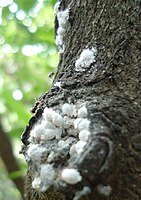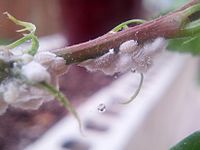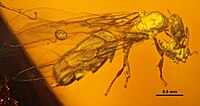Mealybug
This article needs additional citations for verification. (February 2017) |
| Pseudococcidae | |
|---|---|

| |
| Mealybugs on a flower stem in Yogyakarta | |
| Scientific classification | |
| Domain: | Eukaryota |
| Kingdom: | Animalia |
| Phylum: | Arthropoda |
| Class: | Insecta |
| Order: | Hemiptera |
| Suborder: | Sternorrhyncha |
| Superfamily: | Coccoidea |
| Family: | Pseudococcidae Heymons, 1915 [1] |
Mealybugs are insects in the
Description
Mealybugs are
Mealybug females feed on plant sap, normally in roots or other crevices, and in a few cases the bottoms of stored fruit. They attach themselves to the plant and secrete a powdery wax layer (hence the name "mealy" bug) used for protection while they suck the plant juices. In Asia, mango mealybug is considered a major menace for the mango crop. The males on the other hand are short-lived as they do not feed at all as adults and only live to fertilize the females. Male citrus mealy bugs fly to the females and resemble fluffy gnats.
Some
The most serious pests are mealybugs that feed on
Some mealybugs of the Hypogeococcus are used as biological pest controls of invasive cacti in South Africa, including Harrisia balansae, H. martinii, and Opuntia cespitosa.[5]
Fossil specimens of genus Acropyga ants have been recovered from the Burdigalian stage Dominican amber deposits and several individuals are preserved carrying the extinct mealybug genus Electromyrmococcus.[6] These fossils represent the oldest record of the symbiosis between mealybugs and Acropyga species ants.[6]
-
Male hibiscus mealybug, Maconellicoccus hirsutus
-
Formica fusca ants tending a herd of mealybugs
-
Aladybirdpreying on mealybugs
-
Mealybugs on hibiscus plant
-
Electromyrmococcus abductusmealybug
Control methods
Pyrethroids such as permethrin, bifenthrin or cyfluthrin can be used to control mealybugs.[7]
Some gardeners use green lacewing (Chrysopidae) larvae to control mealybug infestations, as the larval lacewings are voracious predators of aphids and other small insects.[8]
Metabolism
Mealybugs have a highly sophisticated metabolism that involves not one but two bacterial
Genera
- Acaciacoccus
- Acinicoccus
- Acrochordonus
- Adelosoma
- Agastococcus
- Albertinia
- Allomyrmococcus
- Allotrionymus
- Amonostherium
- Anaparaputo
- Anisococcus
- Annulococcus
- Anthelococcus
- Antonina
- Antoninella
- Antoninoides
- Apodastococcus
- Artemicoccus
- Asaphococcus
- Asphodelococcus
- Asteliacoccus
- Atriplicicoccus
- Atrococcus
- Australicoccus
- Australiputo
- Balanococcus
- Bessenayla
- Bimillenia
- Birendracoccus
- Boninococcus
- Boreococcus
- Bouhelia
- Brasiliputo
- Brevennia
- Brevicoccus
- Callitricoccus
- Calyptococcus
- Cannococcus
- Capitisetella
- Cataenococcus
- Chaetococcus
- Chaetotrionymus
- Chileputo
- Chlorococcus
- Chnaurococcus
- Chorizococcus
- Chryseococcus
- Cintococcus
- Circaputo
- Cirnecoccus
- Clavicoccus
- Coccidohystrix
- Coccura
- Coleococcus
- Colombiacoccus
- Conicosoma
- Conulicoccus
- Coorongia
- Cormiococcus
- Criniticoccus
- Crisicoccus
- Crocydococcus
- Cryptoripersia
- Cucullococcus
- Cyperia
- Cypericoccus
- Cyphonococcus
- Dawa
- Delococcus
- Delottococcus
- Densispina
- Discococcus
- Distichlicoccus
- Diversicrus
- Drymococcus
- Dysmicoccus
- Eastia
- Ehrhornia
- Electromyrmococcus †
- Epicoccus
- Erimococcus
- Eriocorys
- Erioides
- Erium
- Eucalyptococcus
- Eumirococcus
- Eumyrmococcus
- Eupeliococcus
- Euripersia
- Eurycoccus
- Exilipedronia
- Farinococcus
- Ferrisia
- Ferrisicoccus
- Fijicoccus
- Fonscolombia
- Formicococcus
- Gallulacoccus
- Geococcus
- Glycycnyza
- Gomezmenoricoccus
- Gouxia
- Greenoripersia
- Grewiacoccus
- Hadrococcus
- Heliococcus
- Heterococcopsis
- Heterococcus
- Heteroheliococcus
- Hippeococcus
- Hopefoldia
- Humococcus
- Hypogeococcus[5]
- Iberococcus
- Idiococcus
- Indococcus
- Inopicoccus
- Ityococcus
- Kenmorea
- Kermicus
- Kiritshenkella
- Lachnodiella
- Lachnodiopsis
- Lacombia
- Laingiococcus
- Laminicoccus
- Lankacoccus
- Lantanacoccus
- Lenania
- Leptococcus
- Leptorhizoecus
- Liucoccus
- Lomatococcus
- Londiania
- Longicoccus
- Maconellicoccus
- Macrocepicoccus
- Maculicoccus
- Madacanthococcus
- Madagasia
- Madangiacoccus
- Madeurycoccus
- Malaicoccus
- Malekoccus
- Mammicoccus
- Marendellea
- Mascarenococcus
- Maskellococcus
- Mauricoccus
- Melanococcus
- Metadenopsis
- Metadenopus
- Miconicoccus
- Mirococcopsis
- Mirococcus
- Miscanthicoccus
- Misericoccus
- Mizococcus
- Mollicoccus
- Mombasinia
- Moystonia
- Mutabilicoccus
- Nairobia
- Natalensia
- Neochavesia
- Neoclavicoccus
- Neoripersia
- Neosimmondsia
- Neotrionymus
- Nesococcus
- Nesopedronia
- Nesticoccus
- Nipaecoccus
- Novonilacoccus
- Octococcus
- Odacoccus
- Ohiacoccus
- Oracella
- Orococcus
- Orstomicoccus
- Oxyacanthus
- Palaucoccus
- Palmicultor
- Paludicoccus
- Pandanicola
- Papuacoccus
- Paracoccus
- Paradiscococcus
- Paradoxococcus
- Paraferrisia
- Paramococcus
- Paramonostherium
- Paramyrmococcus
- Parapaludicoccus
- Parapedronia
- Paraputo
- Pararhodania
- Paratrionymus
- Parkermicus
- Paulianodes
- Pedrococcus
- Pedronia
- Peliococcopsis
- Peliococcus
- Pelionella
- Pellizzaricoccus
- Penthococcus
- Peridiococcus
- Phenacoccus
- Phyllococcus
- Pilococcus
- Planococcoides
- Planococcus
- Pleistocerarius
- Plotococcus
- Poecilococcus
- Polystomophora
- Porisaccus
- Porococcus
- Prorhizoecus
- Prorsococcus
- Pseudantonina
- Pseudococcus
- Pseudorhizoecus
- Pseudorhodania
- Pseudoripersia
- Pseudotrionymus
- Puto
- Pygmaeococcus
- Quadrigallicoccus
- Rastrococcus
- Renicaula
- Rhizoecus
- Rhodania
- Ripersia
- Ritsemia
- Rosebankia
- Saccharicoccus
- Sarococcus
- Scaptococcus
- Seabrina
- Serrolecanium
- Seyneria
- Spartinacoccus
- Sphaerococcus
- Spilococcus
- Spinococcus
- Stachycoccus
- Stemmatomerinx
- Stipacoccus
- Strandanna
- Stricklandina
- Strombococcus
- Synacanthococcus
- Syrmococcus
- Tangicoccus
- Tasmanicoccus
- Telocorys
- Tibetococcus
- Tomentocera
- Trabutina
- Tridiscus
- Trimerococcus
- Trionymus
- Trochiscococcus
- Turbinococcus
- Tylococcus
- Tympanococcus
- Ventrispina
- Villosicoccus
- Volvicoccus
- Vryburgia
- Xenococcus
- Yudnapinna
References
- ^ "Pseudococcidae Heymons, 1915". Integrated Taxonomic Information System.
- PMID 23185505.
- ^ Bettiga, Larry J (8 September 2015). "Assessing Grapevine Leafroll and Red Blotch Disease Impacts in Local Vineyards". ANR Blogs. Salinas Valley Agriculture. Retrieved 23 December 2022.
- S2CID 85645762.
- ^ a b "Cactus control in the Klein Karoo". Rhodes University. 2014-09-17. Retrieved 2021-04-19.
- ^ S2CID 55067700.
- ^ SP290-S-Mealybugs on Ornamentals (Report). The University of Tennessee Agricultural Extension Service. 2003. SP290S-1.5M-5/03(Rev) E12-4615-00-030-03.
- ^ "Cryptolaemus and lacewings for mealybug and scale control" (PDF). Department of Primary Studies, NSW. New South Wales. Retrieved 25 May 2021.
- . Retrieved 18 August 2022.
Further reading
- Jahn, G. C. and J. W. Beardsley (1994). "Big-headed ants, Pheidole megacephala: Interference with the biological control of gray pineapple mealybugs". In D.F. Williams [ed.] Exotic Ants: Biology, Impact and Control of Introduced Species. Boulder, Col.: Westview Press, 199–205. ISBN 9780813386157.
- Jahn, G. C. and J. W. Beardsley (1998). "Presence/absence sampling of mealybugs, ants, and major predators in pineapple". J. Plant Protection in the Tropics 11(1):73–79.
- Jahn, Gary C., J. W. Beardsley, and H. González-Hernández (2003). "A review of the association of ants with mealybug wilt disease of pineapple". Proceedings of the Hawaiian Entomological Society. 36:9–28.
External links
- NCIPM (National Centre for Integrated Pest Management) – Cotton Mealybugs
- Mealy bugs Pseudococcus spp.—BBC gardening advice
- CISR – Vine Mealybug—Center for Invasive Species Research summary on Vine Mealybug
- On the University of Florida / Institute of Food and Agricultural Sciences Featured Creatures website:






